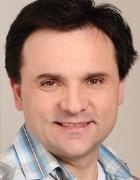Experimentelle Halbleiterphysik
Prof. Martin Stutzmann
Forschungsgebiet
Our work at the Walter Schottky Institut deals with various aspects of new and non conventional semiconductor materials and material combinations: semiconductors with a wide bandgap (GaN, InGaN, AlGaN, diamond, SiC) disordered semiconductors (amorphous, nanocrystalline, and polycrystalline) advanced thin film systems (silicon-based luminescent layers, thin film solar cells, organic/anorganic heterosystems, biofunctionalized semiconductors). Most of these material systems are prepared in our group by suitable deposition techniques (MBE, MOCVD, Plasma-enhanced CVD, e-beam evaporation, sputtering). Their efficient optimization is based on the large pool of structural, optical, and electrical characterization techniques available in our Institute. Complementary to the usual spectroscopic techniques we have developed and employ a variety of highly sensitive methods which enable us to study in particular the influence of defects on the electronic performance of materials and devices. Such techniques include subgap absorption spectroscopy, optically induced capacitance spectroscopy and, in particular, modern spin resonance techniques which are applied to various materials systems and devices for spintronics.
In addition to the preparation and characterization of new semiconductor materials we also work on the modification and processing of semiconductors with pulsed high power laser systems (laser-crystallization, holographic nano structuring, laser-induced etching) and investigate the potential of new material systems for novel device structures. Recent examples include nano structured thin film solar cells, high electron mobility transistors based on AlGaN/GaN hetero structures, as well as UV-detectors, sensors and biosensors.
Learn more about the different research areas on the research pages of the Stutzmann, Brandt, and Garrido groups.
Mitarbeiterinnen und Mitarbeiter der Arbeitsgruppe
Professor
| Photo | Akad. Grad | Vorname | Nachname | Raum | Telefon | |
|---|---|---|---|---|---|---|

|
Prof. Dr. | Martin | Stutzmann | 207S | +49 89 289-12760 |
Sekretariat
| Photo | Akad. Grad | Vorname | Nachname | Raum | Telefon | |
|---|---|---|---|---|---|---|

|
Joana Maria | Meyer Homem de Figueiredo | – | +49 89 289-11561 |
Wissenschaftlerinnen und Wissenschaftler
| Photo | Akad. Grad | Vorname | Nachname | Raum | Telefon | |
|---|---|---|---|---|---|---|

|
M.Sc. | Johannes | Bartl | – | +49 89 289-11523 | |

|
Prof. Dr. | Martin | Brandt | 301S | +49 89 289-12758 | |

|
PD Dr. | Anna | Cattani-Scholz | – | +49 89 289-11535 | |

|
M.Sc. | Theresa | Höldrich | – | +49 89 289-11528 | |

|
M.Sc. | Max | Kraut | – | +49 89 289-11356 | |

|
M.Sc. | Viktoria | Kunzelmann | – | +49 89 289-11369 | |

|
M.Sc. | Florian | Pantle | – | +49 89 289-11315 | |

|
M.Sc. | Felix | Rauh | – | +49 89 289-11398 | |

|
M.Sc. | Hannah | Schamoni | – | +49 89 289-11479 | |

|
Dipl.-Phys. | Patrick | Simon | 109S | +49 89 289-11330 | |

|
M.Sc. | Lina Maria | Todenhagen | – | – | |

|
M.Sc. | David | Vogl | – | +49 89 289-11363 |
Studierende
| Photo | Akad. Grad | Vorname | Nachname | Raum | Telefon | |
|---|---|---|---|---|---|---|

|
Ngoc Quang | Bui | – | – | ||

|
Jonas | Hack | – | – | ||

|
Aron | Lloyd | – | – | ||
Andere Mitarbeiterinnen und Mitarbeiter
| Photo | Akad. Grad | Vorname | Nachname | Raum | Telefon | |
|---|---|---|---|---|---|---|

|
Michael | Fischer | – | +49 89 289-12783 | ||

|
Dr. | Jose Antonio | Garrido Ariza | – | – | |

|
Genet Bacha | Hirpessa | – | – | ||

|
Bernhard | Kratzer | – | +49 89 289-11346 | ||

|
Dipl.-Geogr. | Sonja | Matich | – | 089 289-11569 | |

|
Nick | Schröder | – | +49 89 289-12738 |
Lehrangebot der Arbeitsgruppe
Lehrveranstaltungen mit Beteiligung der Arbeitsgruppe
Abgeschlossene und laufende Abschlussarbeiten an der Arbeitsgruppe
- Characterization of Paramagnetic States in Transmon Qubits
- Abschlussarbeit im Masterstudiengang Physik (Physik der kondensierten Materie)
- Themensteller(in): Martin Brandt
- Demonstration of NV-based Magnetometry
- Abschlussarbeit im Bachelorstudiengang Physik
- Themensteller(in): Martin Brandt
- Photoconductivity in Bismuth Vanadate
- Abschlussarbeit im Bachelorstudiengang Physik
- Themensteller(in): Martin Brandt